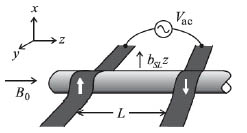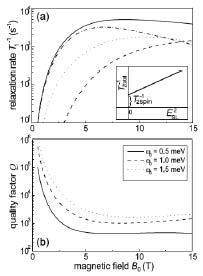Yasuhiro Tokura
Optical Science Laboratory
Stimulated by electron-spin-based proposals for quantum computation,
a growing interest has emerged in realizing the coherent manipulation of
a single electron spin in a solid-state environment. The application of
the electron’s spin―rather than its charge―as a quantum bit (qubit)
is motivated by its potentially long coherence time in solids and the fact
that it comprises a natural two-level system. Single electron spin resonance
(SESR) plays a key role in realizing electron-spin-qubit rotation, however
had not been detected in semiconductor quantum dots (QDs) so far, because
of the necessary high-frequency (10 GHz) selective magnetic field in a
cryogenic (100 mK) setup. Waveguides and microwave cavities as used in
conventional ESR cause serious heating, limiting the operation temperature
to 1 K.
We propose a new SESR scheme that eliminates the need for an externally
applied ac magnetic field, and with the potential of very high and tunable
quality factors. An ac voltage is applied to let an electron in a QD oscillate
under a static slanting Zeeman field. This effectively provides the electron
spin with the necessary time-dependent magnetic field. Note the analogy
with the Stern-Gerlach experiment, where the spin and orbital degrees of
freedom are coupled by employing an inhomogenous magnetic field. The spatial
oscillation of the electron within the QD involves the hybridization of
orbital states.
We estimated expected coherence time of this qubit and demonstrated that
single-qubit rotation and the controlled-NOT operation are possible. This
qubit is easier to manipulate than a spin qubit and has a better quality
factor than a charge qubit. The concept is general and can be applied to
a range of systems, such as single wall carbon nanotubes, GaAs, and SiGe
QDs. This scheme also allows for the measurement ofthe intrinsic single
electron spin coherence time.
[1] Y. Tokura et al., Phys. Rev. Lett. 96 (2006) 047202.
 |
 |
|||
|